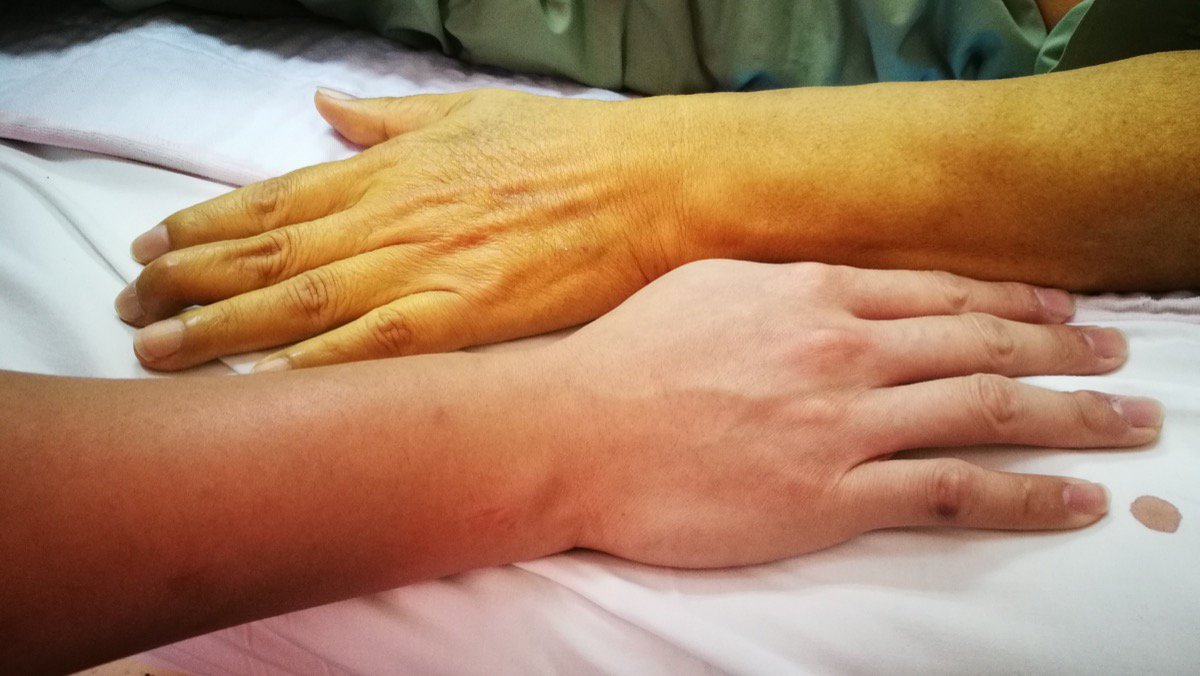Common Symptoms Linked To Liver Cancer
An average adult liver is relative in size to a standard football and sits on top of the stomach and underneath the diaphragm and is responsible for breaking down toxins in the blood. Multiple forms of cancer can develop in an individual's liver. Hepatocellular carcinoma starts in the primary type of liver cell called a hepatocyte. Less common forms of liver cancer include hepatoblastoma and intrahepatic cholangiocarcinoma. Secondary liver cancer or cancer in another part of the body that spreads to the liver is more common than cancer that primarily develops in the liver. A liver cancer diagnosis can be made using ultrasound, MRIs, CT scans, blood tests, and liver tissue biopsy.
Numerous classic symptoms occur in individuals affected by liver cancer. Reveal these now.
Jaundice

Jaundice is a condition where an individual's skin or the white part of their eyes turn yellow. Bilirubin is a resulting compound of the process of red blood cell breakdown. When bilirubin is broken down by the liver, it produces a compound called urobilin with a potent yellow pigment. Urobilin is excreted from the body through the urine and gives it the yellow coloring. Bilirubin is also responsible for the yellowing that occurs in the last stages of the bruise healing process. Bilirubin in healthy individuals is removed through the stool and the urine after being processed in the liver. The cells that make up a cancerous tumor in the liver can eventually crowd out and replace the healthy, functional liver cells. Malignant tumors also cause liver tissues to become damaged, producing cirrhosis. Rarely, a tumor can grow into or large enough to obstruct the flow of bile from the liver into the small intestine. It is a combination of these factors that results in the accumulation of bilirubin in the blood that leeches into the skin and white of the eye.
Continue reading to learn more about the symptoms linked to liver cancer now.
Unexpected Weight Loss

An individual affected by liver cancer can experience unexpected weight loss. Over two-thirds of all individuals diagnosed with cancer have wasting of the body tissue (cachexia). Body fat and skeletal muscle are the types of tissue most commonly affected by wasting. The first mechanism that causes weight loss and wasting in affected individuals is associated with the liver's role in fat digestion. The liver produces bile, which is secreted into the small intestine to assist with breaking fats and other substances down into units the intestine can absorb. Liver cancer stops the liver from being able to produce enough bile for this process. Less commonly, a tumor can block the bile duct and inhibits bile from reaching the small intestine. Fats that aren't digested are not absorbed and are excreted in the stool. Fats also cannot be transported throughout the body when the liver can no longer produce fat transporting proteins. The malfunctions in fat absorption and deposition result in weight loss. Other symptoms such as appetite loss and feeling full easily also produce unexpected weight loss in liver cancer patients.
Loss Of Appetite

An individual experiencing a loss of appetite may be affected by liver cancer. The liver is already a relatively large organ in the body that sits directly on top of the stomach. Any mechanism that causes the stomach to become compressed can cause the individual to feel full when they have eaten very little or nothing at all. This feeling of fullness causes a loss in the desire to eat food. A liver tumor can grow to a large size before actual liver cell displacement begins to occur. The liver as a whole becomes enlarged, causing the stomach to become compressed. Stomach compression worsens when the affected individual is in an upright position due to gravity. Another mechanism responsible for the loss of appetite in liver cancer is the buildup of toxins in the body. Malignancy causes the liver to have a diminished ability to filter and breakdown toxins in the blood. This toxicity causes multiple digestive symptoms, including nausea and vomiting. An individual with these digestive symptoms will lose their desire to eat.
Read more about the major warning signs of liver cancer now.
White And Chalky Stools

Individuals affected by liver cancer can have white and chalky stool. Bile is a substance required for the proper digestion of fats. The liver produces bile, and it is stored in the gallbladder until it is needed for digestion in the small intestine. Bile is also the substance that gives an individual's stool its brown color. Light stools occur when they are composed of a trivial amount or no bile. Liver cancer in an advanced stage can compromise liver function to the point where it is not producing any bile to aid in digestion. Healthy liver cells responsible for this function are replaced by rapidly multiplying and non-functional cancer cells and dense, fibrous scar tissue. Depending on the location and position of the liver tumor, the tube that carries bile from the liver to the small intestine or the bile duct can become compressed. If cancer grows into, around, or down the bile duct, it can stop bile from draining into the small intestine. When bile does not reach the intestine due to lack of production or obstruction, the affected individual has white and chalky stools.
Get more details on the symptoms associated with liver cancer now.
Abdominal Swelling

Abdominal swelling is a common symptom seen in individuals affected by liver cancer. General abdominal swelling occurs due to the enlargement of the liver by the rapid growth of the cancerous tumor. Additionally, both the cancerous tumor growth and cirrhosis from liver tissue damage can cause the buildup of pressure in the liver. Increased pressure in the liver does not allow adequate amounts of blood to pass through the veins, resulting in a backup of blood in the veins. Naturally occurring mechanisms are in place that causes fluid to leech from the veins into neighboring tissues when there is an accumulation or pooling of blood. The fluid may leak into the inner peritoneum that contains the liver and other organs, or it can leak into the space between the inner and outer peritoneum layers. The peritoneum is responsible for producing a trivial amount of fluid between its layers to assist with lubrication and to protect the organs. Cancerous cells can cause the lining to become inflamed and produce excess fluid as a result. Liver cancer can obstruct the lymph vessels responsible for draining excess fluid, also allowing it to buildup in the abdomen.